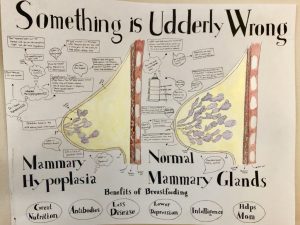I expanded on the objectives focusing around how lactation is induced and maintained as well as the benefits to breastfeeding.
When mothers aren’t able to breast feed there can be a few things that are causing this problem, from latching issues to a poor milk supply. A poor milk supply can be caused by a lack of glandular tissue, this is called breast hypoplasia. Breast hypoplasia is characterized as having insufficient glandular tissue development, making it very difficult for mothers to breast feed. Some signs or symptoms of this condition are asymmetry, more than 4cm of flat space between breasts, overly large and bulbous areolae, tubular shaped breasts, and lack of breast changes during pregnancy (Arbour et. al, 2013). When a mother has hypoplasia, she can produce milk, but it is not a high enough volume to provide for her baby. Mothers who suffer from this condition may be given galactagogue, a medication or natural herb to help increase milk volume. A good example of one is fenugreek, an herb/spice that is used all around the world and has been known medicinally to stimulate milk production (Bazzano et. al, 2013). The cause of this condition is not known, but it is theorized that childhood radiation exposure may play a role as well as genetic predisposition (Arbour et. al, 2013).


Hayley’s STEAM project focuses on healthy breast tissue versus breasts with mammary hypoplasia.
Breast feeding has many benefits for the body, including providing important antibodies for the baby, reducing the risk of disease, and provides essential nutrition. Breast hypoplasia occurs when there is a lack of glandular tissue in the breast, which makes it very difficult for mothers to be capable of breast feeding due to the minimal amount of breast tissue that can produce breast milk. It is still possible to breast feed with hypoplastic breasts as there is still usually a small amount of milk supply, however, the baby will most likely need supplemental nutrition. Breast hypoplasia is present from birth but is generally not known until the woman becomes pregnant. The breast tissue does not fully develop and during pregnancy the breasts will not go through the normal changes. In some cases only one breast may be hypoplastic, which still allows for successful nursing from the other breast.